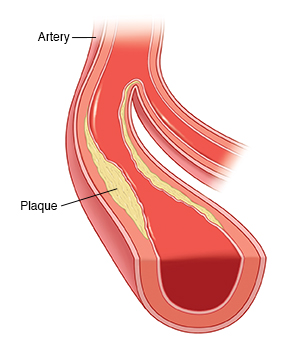Diabetes and Peripheral Arterial Disease (PAD)
Diabetes and Peripheral Arterial Disease (PAD)

How diabetes can lead to PAD
Diabetes can hurt your arteries. If diabetes is not controlled well, blood sugar levels will be high. High blood sugar can make the artery walls rough. A waxy substance in the blood called plaque can then build up on the artery walls. This plaque contains cholesterol. This makes it harder for blood to flow through your arteries. This limits blood flow to your arms and legs, which causes damage in the tissues. The feet are most at risk of tissue damage. If tissue damage is very bad, then toes, feet, or even legs may need to be removed (amputated). But blood sugar and cholesterol levels can be controlled. This is done with nutrition and exercise. Weight loss and medication may also help. And proper foot care is very important for people with PAD.
If diabetes is not controlled
Uncontrolled diabetes can cause many complications, including:
Heart disease
Stroke
Kidney damage or kidney failure (nephropathy)
Liver disease
Digestion problems
Nerve damage (neuropathy)
Eye damage (retinopathy)
Sexual dysfunction
Periodontal (gum) disease
Needing a toe, foot, or leg amputated (if you also have PAD)
If diabetes is controlled
Controlling diabetes can reduce your risk for serious health problems, including:
Heart disease and stroke
Kidney disease
Eye disease
Neuropathy
With proper foot care, the need for amputation
Updated:
October 14, 2017
Sources:
Comorbidities and complications of type 2 diabetes mellitus in children and adolescents. UpToDate, Diabetic autonomic neuropathy of the gastrointestinal tract. UpToDate, Epidemiology, risk factors, and natural history of peripheral artery disease. UpToDate, Glycemic control and vascular complications in type 2 diabetes mellitus. UpToDate
Reviewed By:
Hurd, Robert, MD,Image reviewed by StayWell medical illustration team.,Sather, Rita, RN